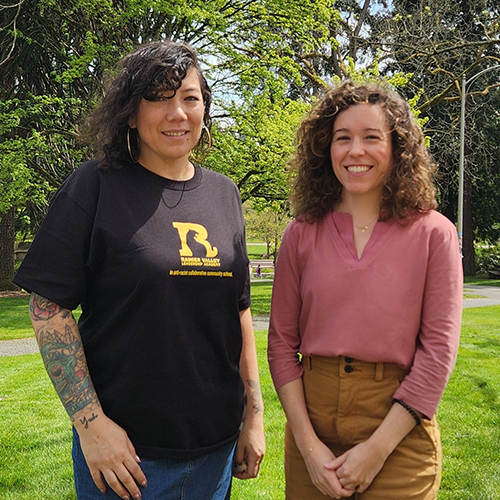Growing up in Richmond, California, Maurice Woods (‘95, ‘05) wanted out. And the way out, he thought, was through sports or music. “In my neighborhood we didn’t know many other options,” he says.
Woods, now a successful graphic designer, wants inner city kids to see design as another option. So he created the Inneract Project, a summer program for inner city youth, offered through the School of Art.
When he arrived at the UW as a freshman, Woods would have seemed an unlikely candidate to create such a program. A gifted athlete with the height to match (he’s 6’10”), Woods nabbed a basketball scholarship and envisioned a career in the NBA. But after a rocky start on the Husky basketball team, he realized he needed a backup plan.

“When I realized I might not make it to the NBA, I didn’t know what to do,” Woods recalls. “I was kind of stuck.” Woods had always enjoyed art, so his mother suggested that he try a design course. “I took one class and just loved it,” he says. “It just felt natural to me.”
Despite frequent road trips with the Husky basketball team, Woods was determined to succeed. He frequently completed design assignments in his hotel room at 2 a.m., while his roommate slept.
“What was so memorable about Mo was that he was playing basketball all the time but he was the first one in class and the first one to put his work on the wall [to be critiqued],” says Christopher Ozubko, UW professor of design and director of the School of Art. “He really wanted this and worked hard. He had so much discipline.”
After graduating, Woods played basketball professionally in Europe for seven years, freelancing for design firms during the summer. After retiring from basketball in 2001, he worked as a designer for two years. He then returned to the UW for a master’s degree in visual communication design, where he dreamed up the Inneract Project.
Woods was taking a course in which students were asked to find a way to use design to change the world. He began thinking about the community in which he was raised, and “it started to build from that,” he recalls. “The idea was to expose inner city kids to design. I wrote a proposal, and my professor, Annabelle Gould, encouraged me to see if it could be realized.”
Through his connections as a community center basketball coach, Woods was able to secure a community center location for Inneract. He planned the curriculum and taught the program to students ages 10 to 16, creating design assignments that “got the students thinking about how to solve things visually.” The group also met with designers at Adobe, Starbucks, and other companies. Impressed with the program, Ozubko invited Woods to offer it at the School of Art the following summer.
Since earning his MFA degree in 2005, Woods has returned to San Francisco but remains intent on continuing the Inneract Project. He and Ozubko redesigned the program so that UW Design graduate students could teach it. Tom Futrell, Cassie Klinger, and Tojo Andrianarivo volunteered their time in 2007. Woods flew to Seattle to discuss Inneract with them and to speak with participants on the program’s first day; he made a second visit to attend a culminating exhibit of the participants’ work at the Jacob Lawrence Gallery.

“When Mo talks to these kids about design and why it is important that they consider it as an option, he is so passionate about it,” says Ozubko. “He’s got them. He is really a great ambassador for design.”
Woods is currently developing an Inneract Project for the San Francisco Bay area. “I’m expecting that this program will eventually be national,” says Woods. “That’s my goal.”
More Stories

Learning Through Storytelling
Through a UW-led storytelling workshop and course, English language learners in the Seattle area strengthened their language skills and built community.

All the World's a Stage — and a Game
Students in DRAMA 480 learn how techniques used in game design can be adapted for interactive theater productions.

Two Majors, Complementary Skills
Elizabeth Xiong (2024), a double major in art history and computer science, shares how she gained different and complementary skills from each major.